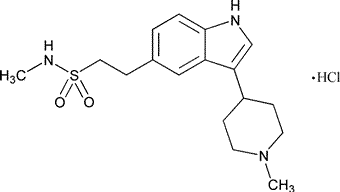Naratriptan Hydrochloride
»Naratriptan Hydrochloride contains not less than 98.0percent and not more than 101.0percent of C17H25N3O2S·HCl,calculated on the anhydrous and solvent free-basis.
Packaging and storage—
Preserve in tight containers,and store below 30 .
.
USP Reference standards á11ñ—
USP Naratriptan Hydrochloride RS.USP Naratriptan Related Compound A RS.USP Naratriptan Related Compound B RS.
NOTE—When performing assays and tests,store all standard,system suitability,and sample solutions in a cool place,protected from light.
Identification—
B:
The retention time of the major peak in the chromatogram of the Assay preparationcorresponds to that in the chromatogram of the Standard preparation,as obtained in the Assay.
C:
It meets the requirements of the test for dry chlorides under Chloride á191ñ.
Water,Method Iá921ñ:
not more than 0.5%.
Heavy metals,Method IIá231ñ:
0.002%.
Chromatographic purity—
0.05M Ammonium phosphate buffer—
Dissolve 5.75g of monobasic ammonium phosphate in 1000mLof water,and adjust with phosphoric acid to a pHof 3.00±0.05.
Solution A—
Prepare a filtered and degassed mixture of 0.05M Ammonium phosphate bufferand acetonitrile (97:3).
Solution B—
Prepare a filtered and degassed mixture of 0.05M Ammonium phosphate bufferand acetonitrile (4:1).
Mobile phase—
Use variable mixtures of Solution Aand Solution Bas directed for Chromatographic system.Make adjustments if necessary (see System Suitabilityunder Chromatography á621ñ).
Resolution solution—
Dissolve accurately weighed quantities of USP Naratriptan Hydrochloride RSand USP Naratriptan Related Compound B RSin water to obtain a solution having known concentrations of about 0.11mg per mLand 0.11µg per mL,respectively.
Test solution—
Dissolve an accurately weighed quantity of Naratriptan Hydrochloride in water to obtain a solution having a known concentration of about 0.11mg per mL.
Chromatographic system (see Chromatography á621ñ)—
The liquid chromatograph is equipped with a 225-nm detector and a 4.6-mm ×15-cm column that contains 4-µm packing L1.The column temperature is maintained at 40 .The flow rate is about 1.5mLper minute.The chromatograph is programmed as follows.
.The flow rate is about 1.5mLper minute.The chromatograph is programmed as follows.
Chromatograph the Resolution solution,and record the peak responses as directed for Procedure:the relative retention times are about 1.04for naratriptan related compound Band 1.0for naratriptan;and the resolution,R,between naratriptan and naratriptan related compound Bis not less than 1.5.
| Time (minutes) |
Solution A
(%) |
Solution B
(%) |
Elution |
| 0–35.0 | 100®0 | 0®100 | linear gradient |
| 35.0–40.0 | 0 | 100 | isocratic |
| 40.0–40.1 | 0®100 | 100®0 | linear gradient |
| 40.1–50.0 | 100 | 0 | re-equilibration |
Procedure—
Inject a volume (about 20µL)of the Test solutioninto the chromatograph,record the chromatogram,and measure the areas for all of the peaks.Calculate the percentage of each impurity in the portion of Naratriptan Hydrochloride taken by the formula:
In addition to not exceeding the limits listed in the accompanying table,not more than 0.1%of any other individual impurity is found;and not more than 1.5%of total impurities is found.
100(ri/F)/[rN+S(ri/F)],
in which Fis the relative response factor (see the accompanying table for values)for each impurity;riis the peak response for each impurity;and rNis the naratriptan peak response (see the accompanying table for limits).
| Relative retention time |
Relative response factor (F) |
Limit (%) |
| 0.93 | 1.0 | 0.2 |
| 1.04 | 0.6 | 0.1 |
| 1.18 | 0.6 | 0.2 |
| 1.25 | 0.4 | 0.2 |
| 1.36 | 0.6 | 0.3 |
| 1.44 | 0.5 | 0.1 |
| 1.48 | 1.0 | 0.2 |
| 1.90 | 1.00 | 0.2 |
Organic volatile impurities,Method IVá467ñ:
meets the requirements.
Solvent—
Use dimethyl sulfoxide.
Assay—
0.01M Triethylamine phosphate buffer—
Dilute 0.6mLof phosphoric acid with water to 900mL,and adjust with triethylamine to a pHof 2.5.
Mobile phase—
Prepare a filtered and degassed mixture of 0.01M Triethylamine phosphate bufferand isopropyl alcohol (9:1).Make adjustments if necessary (see System Suitabilityunder Chromatography á621ñ).
Resolution solution—
Dissolve accurately weighed quantities of USP Naratriptan Hydrochloride RS,USP Naratriptan Related Compound A RS,and USP Naratriptan Related Compound B RSin Mobile phaseto obtain a solution having known concentrations of about 0.11mg per mL,0.11µg per mL,and 0.11µg per mL,respectively.
Standard preparation—
Dissolve an accurately weighed quantity of USP Naratriptan Hydrochloride RSin Mobile phase,and dilute quantitatively,and stepwise if necessary,with Mobile phaseto obtain a solution having a known concentration of about 0.11mg per mL.
Assay preparation—
Transfer about 11mg of Naratriptan Hydrochloride,accurately weighed,to a 100-mLvolumetric flask,dissolve in and dilute with Mobile phaseto volume,and mix.
Chromatographic system (see Chromatography á621ñ)—
The liquid chromatograph is equipped with a 282-nm detector and a 4.6-mm ×15-cm column that contains 3-µm packing L11.The column temperature is maintained at 35 .The flow rate is about 1.5mLper minute.Chromatograph the Resolution solution,and record the peak responses as directed for Procedure:the relative retention times are about 0.9for naratriptan related compound A,1.0for naratriptan,and 1.1for naratriptan related compound B;and the resolution,R,between naratriptan related compound Aand naraptriptan and between naratriptan related compound Band naratriptan is not less than 1.5.Chromatograph the Standard preparation,and record the peak responses as directed for Procedure:the relative standard deviation for replicate injections is not more than 1.5%.
.The flow rate is about 1.5mLper minute.Chromatograph the Resolution solution,and record the peak responses as directed for Procedure:the relative retention times are about 0.9for naratriptan related compound A,1.0for naratriptan,and 1.1for naratriptan related compound B;and the resolution,R,between naratriptan related compound Aand naraptriptan and between naratriptan related compound Band naratriptan is not less than 1.5.Chromatograph the Standard preparation,and record the peak responses as directed for Procedure:the relative standard deviation for replicate injections is not more than 1.5%.
Procedure—
Separately inject equal volumes (about 10µL)of the Standard preparationand the Assay preparationinto the chromatograph,record the chromatograms,and measure the areas for the major peaks.Calculate the quantity,in mg,of C17H25N3O2S·HCl in the portion of Naratriptan Hydrochloride taken by the formula:
100C(rU/rS),
in which Cis the concentration,in mg per mL,of USP Naratriptan Hydrochloride RSin the Standard preparation;and rUand rSare the peak responses obtained from the Assay preparationand the Standard preparation,respectively.
Auxiliary Information—
Staff Liaison:Salvador C.Salado,M.S.,Scientist and Latin American Liaison
Expert Committee:(PA3)Pharmaceutical Analysis 3
USP28–NF23Page 1339
Pharmacopeial Forum:Volume No.30(4)Page 1266
Phone Number:1-301-816-8165
